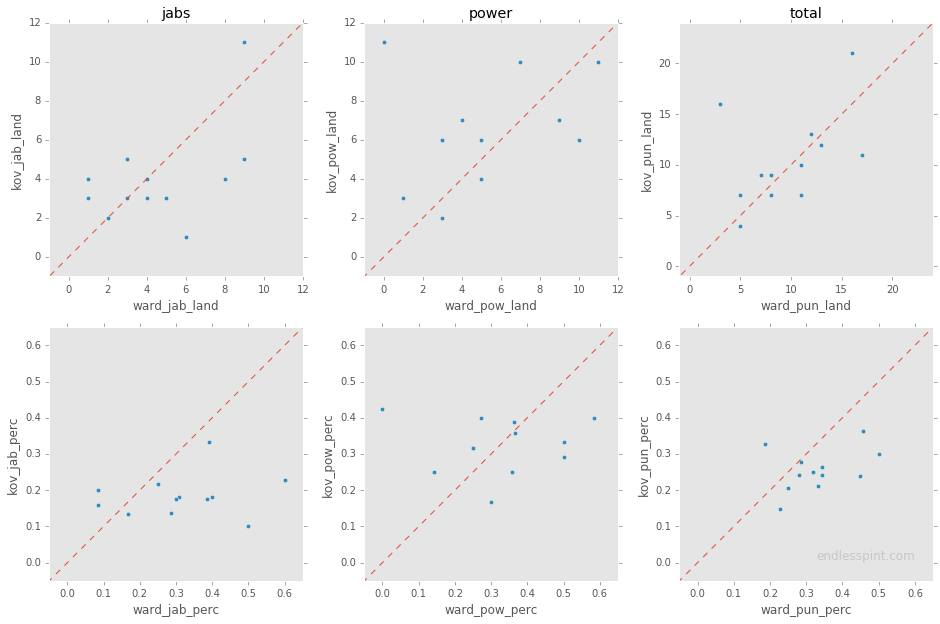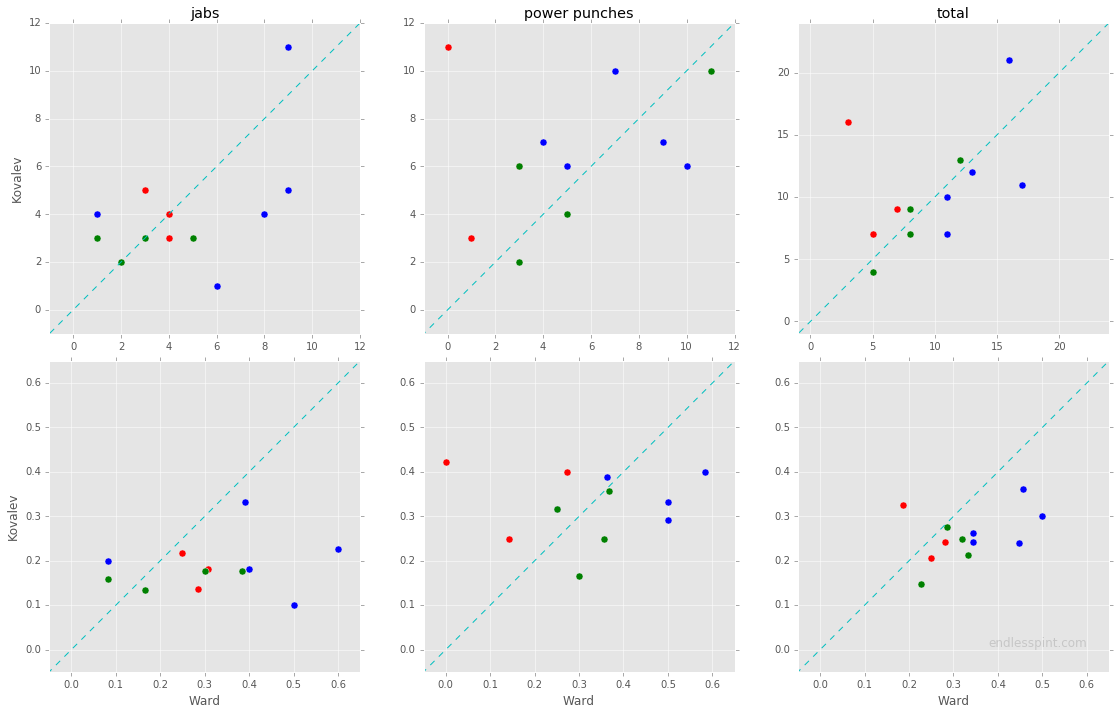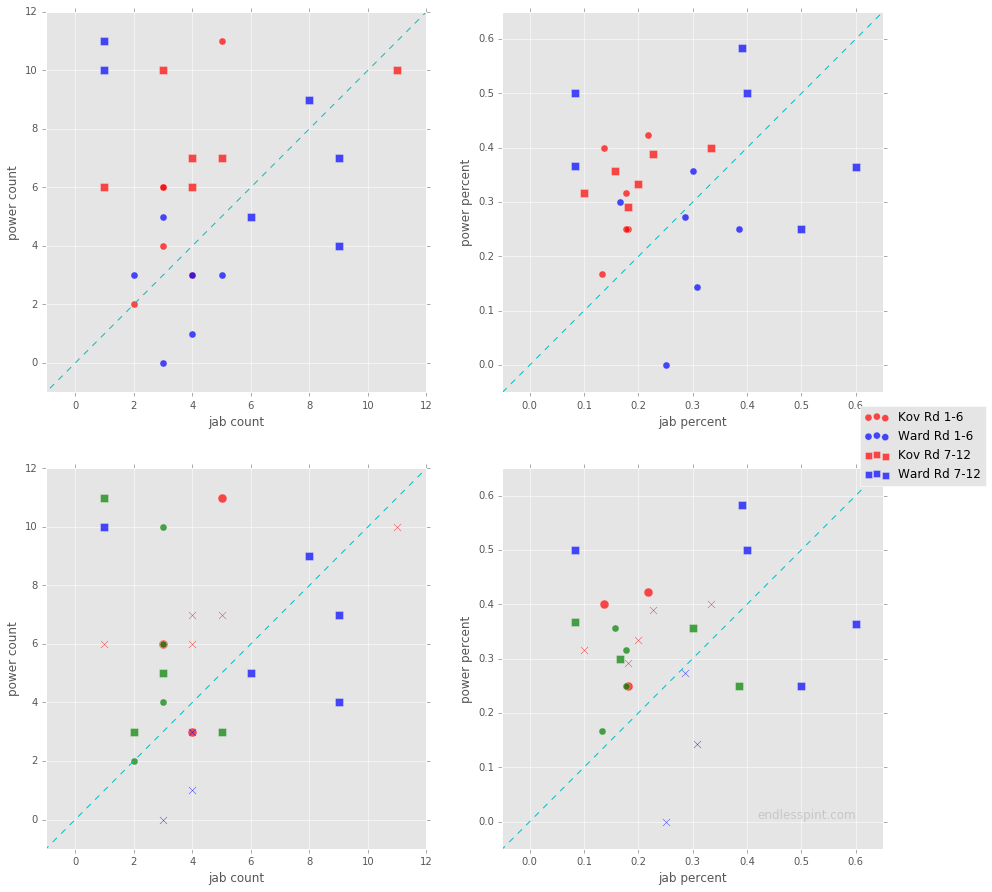Still too Close to Call
Nice build up, two top quality fighters, one hell of a tactical and willful bout, one knockdown and a controversial decision. That’s boxing, baby!
I have my impressions on who won between Kovalev/Ward I (let’s all hope there’s a sequel in the near future) and am apparently curious enough about the result to want to dig deeper in order to get a more complete take.
This three part (more or less) piece will explore the fight from several different angles.
First we’ll see what social media thought was happening in the moment. Then we will take a closer look at the round features and judges’ score cards (how do they line up?). Finally, there will be a review of the respective fighter’s ELO ratings coming into and exiting the fight.
What do the Masses Have to Say?
I pulled the fight night tweets associated with the two primary hashtags, #KovalevWard and #WardKovalev, focused in on the bout itself, and identified the round and rest period time ranges.
Data Source: Twitter
The purpose of narrowing in on the rounds and breaks was two-fold, to make the above graph (pretty!) and to just use the scores in the moment. I wanted to get the “as it happened” impression from fight fans. I was not interested in Monday morning quarterbacks or rationalizations of any sort.
What I found was a whole lot of handwringing and excited viewers. Many rounds went unscored on an individual basis, many times people simply commentating on how close and tense the fight was. The scores varied with wide margins on both sides but overall the ultimate proportions fall in line with most people’s expectations, though there were some surprises from my perspective (see round 12, which I thought was much closer).
Below are the percentages associated with how people saw the fight on a round-by-round basis. The darker the red the more Kovalev was favored. Meanwhile, the darker the blue the more impressed Twitter’ers (I guess that’s one way of spelling it) were with Ward.
Data Source: Twitter
What we see is the story of two halves. Early Kovalev domination, including the knockdown in round 2,1 followed by a steady Ward resurgence. Going on the straight majority votes it is clear that the fight is a six rounds to six split, with Kovalev winning by a point due to the knockdown. That observation is boring, however, and obscures individual scorecards by aggregating all of the votes.
In order to get a slightly more nuanced appreciation for how close the fight was I used these votes as probabilities, ran one thousand simulations of the bout, and came up with a range of possibilities for scoring it.
Data Source: Twitter
Turns out the judges’ decision of five rounds to Kovalev and seven to Ward, a one point win in the opposite direction from above, happens in 47.4% of the simulated bouts (Kovalev winning 5 rounds or less). This would suggest that the judges and Twitter-folk did not see it too differently. However, there is that second peak in the chart above. Just over round 6. And it’s higher than the one for round 5. In nearly one third of all simulations (32.2%) Kovalev wins six rounds. So who “deserved” to win? Still too tough to call.
Round Features v. Judges’ Cards
Having seen how the Twitter folk saw the fight we now turn our attention to the ringside judges. To help give us context regarding what people were seeing we bring in the fight numbers as measured by CompuBox.
The data is built up of two primary features: jabs and power punches. These numbers are combined, for total punch output, and broken down into thrown and connected hits, for percentages. We will take all of these criteria into consideration and review.
Below is a head-to-head graphical representation by round of jabs, power, and total punches. The top row shows the actual counts for each of the aforementioned measures. The second row shows the same data as percentages. In each of the charts I have provided a 45-degree line to help provide a visual cue when one fighter is outperforming the other for any specific round.

Data Source: CompuBox
These two rows appear to tell slightly different stories. In the first we see a nearly balanced fight, depending on how you favor jabs versus power shots. The second row tells a much more partisan tale. Here we see that Ward holds a definitive advantage.
Taking a look at this data in another way I identified each round with the judges’ scores. There were eight rounds that were unanimously agreed upon, three for Kovalev (red) and five in Ward’s favor (blue), and four that were split (green). I replotted the data points with colors to identify the judges’ take on the fighters’ performance.

Data Source: CompuBox
With the added context of the official score cards you might say that Ward was favored in more active rounds, possibly due his higher accuracy shining through in busier rounds. Beyond that I am a bit hard pressed to distinguish how the split rounds should be distributed. While certain split/green rounds appear closer to Kovalev they often times fall into Ward’s half of the graph. The fact that Kovalev had a knockdown in one of the rounds doesn’t exactly help matters. That round goes to the fighter who scored the knockdown in the absence of a remarkable in-round comeback by the floored opponent. For our purposes punch numbers from round two may be difficult to generalize to other rounds.
Setting aside the head-to-head comparison I wanted to visualize the performances side-by-side. The benefit of splitting the fighter inputs from each other is to combine jabs and power punches for a single fighter (again per round). Plotting the two-feature data points, with distinguishing colors and markers, could allow for a more complete view of the fighters’ round performances. Unfortunately we lose the connection with the other fighter’s contributing performance in the same round.
I could have added distinguishing colors/markers for each round but that would have been too much of a CF.2 Instead I decided to meet the need halfway. We already know this is a fight of two halves so I distinguished the markers for fighter by color, again red v. blue, and rounds by shape, circle (1st half of bout) v. square (2nd half).
What we see in the first row below is Kovalev routinely landing more power punches than jabs and doing so at a better percentage. Ward had a varied “approach”. The blue squares show us that it was in the latter half of the fight that Ward raised his output and connect percentage, lending strong evidence to the way the fight was scored. In fact, if we take a look at the bottom right graph below, we see that in all of the five rounds Ward swept he connected at +50% for jabs or power punches. Now that is impressive.3
Less impressive is my rendering of the data on the second row below. What I attempted to show were outright round wins by fighter using full red/blue geometric figures, outright fighter round loses by red/blue “X’s”, and split rounds in green. In the latter instance of split rounds I kept the circles for Kovalev and boxes for Ward. This association of shapes is not an exact match with the first row and may lead to confusion. Ultimately I went with this less than perfect representation because I found it the least bad of the candidates I was working with.

Data Source: CompuBox
Having come to the end of basic exploratory visual analysis I switched my attention to learning and prediction. This was a tough thing to ask due to the small number of examples. I partly mitigated this by creating three instances of each round, one for the decision of each judge. With the punch stats as features and the judge decisions as labels I applied several quick techniques to see what if anything popped out.
Using bagging (7-5 Ward), random forest (7-5 Ward), kNN (6-6), and k-means (6-6) my appreciation for how close the rounds were, or rather the fight as a whole, grew. What I was hoping to find where anomalies in the round statistics that one of these techniques would pick up on, leading to a significantly different result. That might have suggested a round or two that were more similar to one fighter’s better performance over another being “unfairly” given to the wrong fighter. Unfortunately from the point of view of a “gotcha” piece I was not able to determine such a thing having happened.
But this isn’t meant as a gotcha piece. This is a search for clarification to the judges’ cards and what I have clarified, at least for myself, is a certain level of consistency among the data to give me some reassurance to the decision.
Well, Hello ELO
We have taken a look at the live in-fight viewer impressions based on tweet reactions and reviewed the fight/round features as they stacked up with the official judges. It is now time to wrap this piece up by going back to the beginning and asking what the fight records of Kovalev and Ward told us coming into the fight.
In order to develop a quantified judgement of the bout favorite and fighters’ forms I went about calculating the ELO rating of both Kovalev and Ward. This rating allowed me to determine the favorite and likelihood of victory. I am not going to bore you with the details of getting, cleaning, and using the data (I have a silly take on that here) but suffice it to say I took each fighter’s record, identified their opponents, their opponents’ opponents, and so on going back to January 1, 2001. That was nearly 16 years of fights for the bouts that fit into this lineage. At the end of the day the following is what is left to talk about.
I wish to start big picture and drill down further from there. In the first chart we plot out every fighter’s bout-ending ELO for the relevant time period. The ELO dots for Kovalev and Ward are color-coded, start towards the middle of the chart, and are, naturally the terminating points of the timeline. The chart is not high resolution but you can still see a slight edge with respect to ELO for Ward. Even so it is pretty clear that this was approaching a dead heat. What is also obvious is the shorter, more compact, and more rapid ascendancy of Kovalev. You can describe Ward’s trajectory as a slowburn, while Kovalev’s as one that has been cooking at a higher temperature.
Data Source: BoxRec
If you are not a fight freak and/or did not bother to tally the dots let me inform you that both Kovalev and Ward had 30 professional wins coming into their original showdown. They were both undefeated but Kovalev had one blemish by way of a draw. With a near equal number of fights but a different length of time it is clear who has been the more active fighter. Activity is one thing, and we will touch upon it again, but what was the standard of each fighter’s level of competition?
Data Source: BoxRec
A comparable number of bouts was a convenient coincidence in preparing the above chart. Here we plotted the level of competition by noting the opponent ELO rating at each fighter’s respective professional bout. We see an overall advantage for Ward, and the numbers bear out his having tougher competition, but not recently.4 At the tail end of the chart we see Kovalev’s opponents matching and generally surpassing Ward’s opposition. The numbers bear this out as well.
Data Source: BoxRec
Looking strictly at each fighter’s last five opponents, to get an idea of current form, we see more clearly the tougher competition for Kovalev, and in less than half the amount of time (under two years for Kovalev to Ward’s nearly 4 years to get through the same number of fights). If we extend Kovalev’s recent history to a comparable 45 months we see an activity advantage of 12 fights to 5.
Data Source: BoxRec
Before divulging the ELO ratings and quantitative verdict, let’s look at how the model fared across the 24,000 bouts. I have plotted the actual win percentage against the ELO win probabilities. The 45° line would represent a perfect match, with any misalignment indicating a deviation from actual results. The dots straddle the line while displaying a slight S-curve. I added a trend line to better accentuate this.
Data Source: BoxRec
The model works reasonably well, showing decent accuracy and better precision, though some caveats are in order.5
- I have not given extra points to bouts early in a fighter’s career nor varied the “K” depending on ELO rating level reached (a commonly accepted practice for chess).
- There is no “time off” discounting. Fighters kept their last achieved ELO rating regardless of how long they went between fights.
- Though the majority of the fighters hover around the super middleweight and light heavyweight divisions I have taken no special steps to account for ELO points across weight classes.
- Additionally, no extra consideration was given for how a fighter won or lost. It did not matter if it was by KO, TKO, decision (unanimous, majority, or split), nor what round the fight ended in.
- Finally, well at least the last limitation of my approach I wish to admit to at this point, is my not awarding any extra points to fighters in championship bouts.
This is quite a list of possible weaknesses but I remain confident the model as currently constructed still provides some guidance.
So who had the advantage? The final ELO ratings were 2083 for Kovalev and 2121 for Ward.6 The difference in ratings made Ward the favorite and gave him a 59% chance of victory (the margin grew to 62% when “correcting” with the trend line). However, keep in mind the qualifications above and how they might balcance against the greater Kovalev activity, tougher recent competition, high knock out rate, and Ward moving up in weight.
With the numbers in hand I felt no more confident about making a decision one way or another. Like the fight itself would play out, it seems any which way you cut it and analyze these two fighters against one another you had a tossup, with adequate reasons to favor one fighter over the other, regardless of who you chose.
This has been a fortuitous bout to analyze for the reasons written about here and the many more elsewhere. The high quality skillset, contrasting styles, tale of two fights with a knockdown early on and a Ward resurgence in the latter half, and controversial though not indefensible decision, gave us a bout that will go down with other fights (ahem, Hagler/Leonard) as one people will debate for a long time to come.
Until the rematch. Let’s see if it settles things more decisively than what we have to date.7
Notes
1 Amazingly I didn’t find any knuckleheads who scored the round even or in favor of Ward. It’s the internet, you never know. ↩
2 Or chart junk as Edward Tufte more politely calls it. ↩
3 I initially thought it was a bit fishy that Ward won five rounds straight and unanimously from the beginning of the second half of the bout. It seemed too close to a script. However, when we see the numbers it is clear that his precision was very high for those rounds. This analysis looks at raw numbers as punch outputs only differentiated by jab or power punch. We have not looked at nor is there as yet an adequate way of measuring “pain”. ↩
4 Kovalev’s hist in red/orange/tangerine peaks at a lower opponent ELO rating and skews right. Meanwhile, Ward has a more evenly/normally distributed group of opponents and higher median:
Data Source: BoxRec
↩
5 I messed around with various “K” and win expectancy parameters and the resulting model was the best fit (RMSE against 45° line & trend v. actuals) given a non-exhaustive search. ↩
6 There were many runs but I am only illustrating with a representative sample run; basically a ~40 point ELO difference persisted in Ward’s favor. ↩
7 Depending on how you saw the first fight ELO has a suggestion on how to view the rematch. I threw in a draw result to split the difference (difficult to manage in reality with a 10-8 round but…).